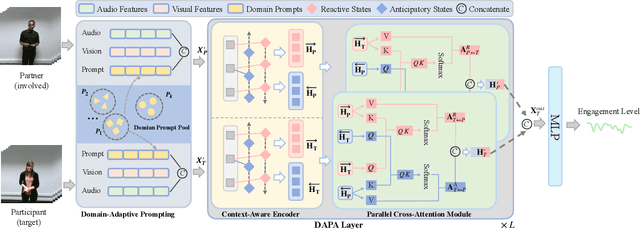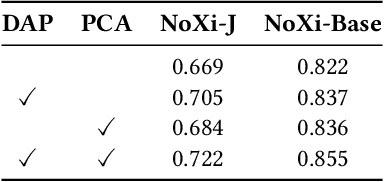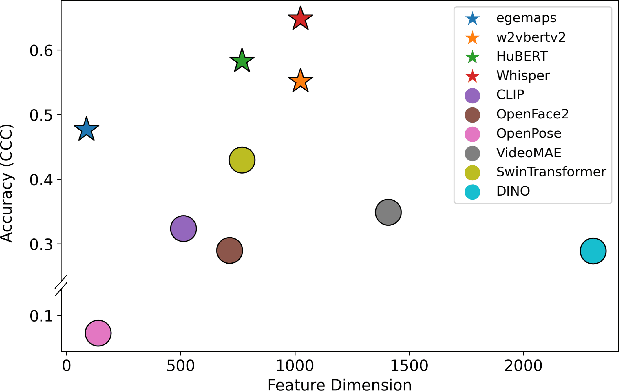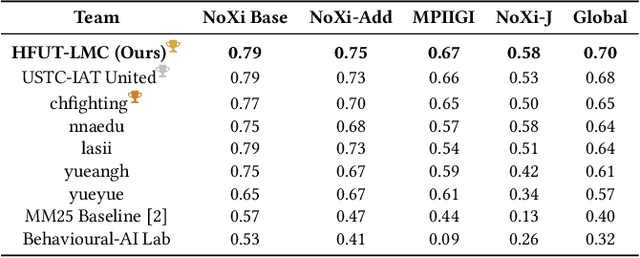Richang Hong
Disentangling Foreground and Background for vision-Language Navigation via Online Augmentation
Oct 01, 2025Abstract:Following language instructions, vision-language navigation (VLN) agents are tasked with navigating unseen environments. While augmenting multifaceted visual representations has propelled advancements in VLN, the significance of foreground and background in visual observations remains underexplored. Intuitively, foreground regions provide semantic cues, whereas the background encompasses spatial connectivity information. Inspired on this insight, we propose a Consensus-driven Online Feature Augmentation strategy (COFA) with alternative foreground and background features to facilitate the navigable generalization. Specifically, we first leverage semantically-enhanced landmark identification to disentangle foreground and background as candidate augmented features. Subsequently, a consensus-driven online augmentation strategy encourages the agent to consolidate two-stage voting results on feature preferences according to diverse instructions and navigational locations. Experiments on REVERIE and R2R demonstrate that our online foreground-background augmentation boosts the generalization of baseline and attains state-of-the-art performance.
Generalizable Engagement Estimation in Conversation via Domain Prompting and Parallel Attention
Aug 20, 2025



Abstract:Accurate engagement estimation is essential for adaptive human-computer interaction systems, yet robust deployment is hindered by poor generalizability across diverse domains and challenges in modeling complex interaction dynamics.To tackle these issues, we propose DAPA (Domain-Adaptive Parallel Attention), a novel framework for generalizable conversational engagement modeling. DAPA introduces a Domain Prompting mechanism by prepending learnable domain-specific vectors to the input, explicitly conditioning the model on the data's origin to facilitate domain-aware adaptation while preserving generalizable engagement representations. To capture interactional synchrony, the framework also incorporates a Parallel Cross-Attention module that explicitly aligns reactive (forward BiLSTM) and anticipatory (backward BiLSTM) states between participants.Extensive experiments demonstrate that DAPA establishes a new state-of-the-art performance on several cross-cultural and cross-linguistic benchmarks, notably achieving an absolute improvement of 0.45 in Concordance Correlation Coefficient (CCC) over a strong baseline on the NoXi-J test set. The superiority of our method was also confirmed by winning the first place in the Multi-Domain Engagement Estimation Challenge at MultiMediate'25.
I$^3$-MRec: Invariant Learning with Information Bottleneck for Incomplete Modality Recommendation
Aug 06, 2025Abstract:Multimodal recommender systems (MRS) improve recommendation performance by integrating diverse semantic information from multiple modalities. However, the assumption of the availability of all modalities rarely holds in practice due to missing images, incomplete descriptions, or inconsistent user content. These challenges significantly degrade the robustness and generalization capabilities of current models. To address these challenges, we introduce a novel method called \textbf{I$^3$-MRec}, which uses \textbf{I}nvariant learning with \textbf{I}nformation bottleneck principle for \textbf{I}ncomplete \textbf{M}odality \textbf{Rec}ommendation. To achieve robust performance in missing modality scenarios, I$^3$-MRec enforces two pivotal properties: (i) cross-modal preference invariance, which ensures consistent user preference modeling across varying modality environments, and (ii) compact yet effective modality representation, which filters out task-irrelevant modality information while maximally preserving essential features relevant to recommendation. By treating each modality as a distinct semantic environment, I$^3$-MRec employs invariant risk minimization (IRM) to learn modality-specific item representations. In parallel, a missing-aware fusion module grounded in the Information Bottleneck (IB) principle extracts compact and effective item embeddings by suppressing modality noise and preserving core user preference signals. Extensive experiments conducted on three real-world datasets demonstrate that I$^3$-MRec consistently outperforms existing state-of-the-art MRS methods across various modality-missing scenarios, highlighting its effectiveness and robustness in practical applications. The code and processed datasets are released at https://github.com/HuilinChenJN/I3-MRec.
* ACM Multimedia 2025 Accepted
Listening to the Unspoken: Exploring 365 Aspects of Multimodal Interview Performance Assessment
Jul 30, 2025Abstract:Interview performance assessment is essential for determining candidates' suitability for professional positions. To ensure holistic and fair evaluations, we propose a novel and comprehensive framework that explores ``365'' aspects of interview performance by integrating \textit{three} modalities (video, audio, and text), \textit{six} responses per candidate, and \textit{five} key evaluation dimensions. The framework employs modality-specific feature extractors to encode heterogeneous data streams and subsequently fused via a Shared Compression Multilayer Perceptron. This module compresses multimodal embeddings into a unified latent space, facilitating efficient feature interaction. To enhance prediction robustness, we incorporate a two-level ensemble learning strategy: (1) independent regression heads predict scores for each response, and (2) predictions are aggregated across responses using a mean-pooling mechanism to produce final scores for the five target dimensions. By listening to the unspoken, our approach captures both explicit and implicit cues from multimodal data, enabling comprehensive and unbiased assessments. Achieving a multi-dimensional average MSE of 0.1824, our framework secured first place in the AVI Challenge 2025, demonstrating its effectiveness and robustness in advancing automated and multimodal interview performance assessment. The full implementation is available at https://github.com/MSA-LMC/365Aspects.
Traits Run Deep: Enhancing Personality Assessment via Psychology-Guided LLM Representations and Multimodal Apparent Behaviors
Jul 30, 2025Abstract:Accurate and reliable personality assessment plays a vital role in many fields, such as emotional intelligence, mental health diagnostics, and personalized education. Unlike fleeting emotions, personality traits are stable, often subconsciously leaked through language, facial expressions, and body behaviors, with asynchronous patterns across modalities. It was hard to model personality semantics with traditional superficial features and seemed impossible to achieve effective cross-modal understanding. To address these challenges, we propose a novel personality assessment framework called \textit{\textbf{Traits Run Deep}}. It employs \textit{\textbf{psychology-informed prompts}} to elicit high-level personality-relevant semantic representations. Besides, it devises a \textit{\textbf{Text-Centric Trait Fusion Network}} that anchors rich text semantics to align and integrate asynchronous signals from other modalities. To be specific, such fusion module includes a Chunk-Wise Projector to decrease dimensionality, a Cross-Modal Connector and a Text Feature Enhancer for effective modality fusion and an ensemble regression head to improve generalization in data-scarce situations. To our knowledge, we are the first to apply personality-specific prompts to guide large language models (LLMs) in extracting personality-aware semantics for improved representation quality. Furthermore, extracting and fusing audio-visual apparent behavior features further improves the accuracy. Experimental results on the AVI validation set have demonstrated the effectiveness of the proposed components, i.e., approximately a 45\% reduction in mean squared error (MSE). Final evaluations on the test set of the AVI Challenge 2025 confirm our method's superiority, ranking first in the Personality Assessment track. The source code will be made available at https://github.com/MSA-LMC/TraitsRunDeep.
GT-Mean Loss: A Simple Yet Effective Solution for Brightness Mismatch in Low-Light Image Enhancement
Jul 27, 2025Abstract:Low-light image enhancement (LLIE) aims to improve the visual quality of images captured under poor lighting conditions. In supervised LLIE research, there exists a significant yet often overlooked inconsistency between the overall brightness of an enhanced image and its ground truth counterpart, referred to as brightness mismatch in this study. Brightness mismatch negatively impact supervised LLIE models by misleading model training. However, this issue is largely neglected in current research. In this context, we propose the GT-mean loss, a simple yet effective loss function directly modeling the mean values of images from a probabilistic perspective. The GT-mean loss is flexible, as it extends existing supervised LLIE loss functions into the GT-mean form with minimal additional computational costs. Extensive experiments demonstrate that the incorporation of the GT-mean loss results in consistent performance improvements across various methods and datasets.
StgcDiff: Spatial-Temporal Graph Condition Diffusion for Sign Language Transition Generation
Jun 16, 2025Abstract:Sign language transition generation seeks to convert discrete sign language segments into continuous sign videos by synthesizing smooth transitions. However,most existing methods merely concatenate isolated signs, resulting in poor visual coherence and semantic accuracy in the generated videos. Unlike textual languages,sign language is inherently rich in spatial-temporal cues, making it more complex to model. To address this,we propose StgcDiff, a graph-based conditional diffusion framework that generates smooth transitions between discrete signs by capturing the unique spatial-temporal dependencies of sign language. Specifically, we first train an encoder-decoder architecture to learn a structure-aware representation of spatial-temporal skeleton sequences. Next, we optimize a diffusion denoiser conditioned on the representations learned by the pre-trained encoder, which is tasked with predicting transition frames from noise. Additionally, we design the Sign-GCN module as the key component in our framework, which effectively models the spatial-temporal features. Extensive experiments conducted on the PHOENIX14T, USTC-CSL100,and USTC-SLR500 datasets demonstrate the superior performance of our method.
Understanding and Benchmarking the Trustworthiness in Multimodal LLMs for Video Understanding
Jun 14, 2025Abstract:Recent advancements in multimodal large language models for video understanding (videoLLMs) have improved their ability to process dynamic multimodal data. However, trustworthiness challenges factual inaccuracies, harmful content, biases, hallucinations, and privacy risks, undermine reliability due to video data's spatiotemporal complexities. This study introduces Trust-videoLLMs, a comprehensive benchmark evaluating videoLLMs across five dimensions: truthfulness, safety, robustness, fairness, and privacy. Comprising 30 tasks with adapted, synthetic, and annotated videos, the framework assesses dynamic visual scenarios, cross-modal interactions, and real-world safety concerns. Our evaluation of 23 state-of-the-art videoLLMs (5 commercial,18 open-source) reveals significant limitations in dynamic visual scene understanding and cross-modal perturbation resilience. Open-source videoLLMs show occasional truthfulness advantages but inferior overall credibility compared to commercial models, with data diversity outperforming scale effects. These findings highlight the need for advanced safety alignment to enhance capabilities. Trust-videoLLMs provides a publicly available, extensible toolbox for standardized trustworthiness assessments, bridging the gap between accuracy-focused benchmarks and critical demands for robustness, safety, fairness, and privacy.
Wi-CBR: WiFi-based Cross-domain Behavior Recognition via Multimodal Collaborative Awareness
Jun 13, 2025Abstract:WiFi-based human behavior recognition aims to recognize gestures and activities by analyzing wireless signal variations. However, existing methods typically focus on a single type of data, neglecting the interaction and fusion of multiple features. To this end, we propose a novel multimodal collaborative awareness method. By leveraging phase data reflecting changes in dynamic path length and Doppler Shift (DFS) data corresponding to frequency changes related to the speed of gesture movement, we enable efficient interaction and fusion of these features to improve recognition accuracy. Specifically, we first introduce a dual-branch self-attention module to capture spatial-temporal cues within each modality. Then, a group attention mechanism is applied to the concatenated phase and DFS features to mine key group features critical for behavior recognition. Through a gating mechanism, the combined features are further divided into PD-strengthen and PD-weaken branches, optimizing information entropy and promoting cross-modal collaborative awareness. Extensive in-domain and cross-domain experiments on two large publicly available datasets, Widar3.0 and XRF55, demonstrate the superior performance of our method.
SignAligner: Harmonizing Complementary Pose Modalities for Coherent Sign Language Generation
Jun 13, 2025Abstract:Sign language generation aims to produce diverse sign representations based on spoken language. However, achieving realistic and naturalistic generation remains a significant challenge due to the complexity of sign language, which encompasses intricate hand gestures, facial expressions, and body movements. In this work, we introduce PHOENIX14T+, an extended version of the widely-used RWTH-PHOENIX-Weather 2014T dataset, featuring three new sign representations: Pose, Hamer and Smplerx. We also propose a novel method, SignAligner, for realistic sign language generation, consisting of three stages: text-driven pose modalities co-generation, online collaborative correction of multimodality, and realistic sign video synthesis. First, by incorporating text semantics, we design a joint sign language generator to simultaneously produce posture coordinates, gesture actions, and body movements. The text encoder, based on a Transformer architecture, extracts semantic features, while a cross-modal attention mechanism integrates these features to generate diverse sign language representations, ensuring accurate mapping and controlling the diversity of modal features. Next, online collaborative correction is introduced to refine the generated pose modalities using a dynamic loss weighting strategy and cross-modal attention, facilitating the complementarity of information across modalities, eliminating spatiotemporal conflicts, and ensuring semantic coherence and action consistency. Finally, the corrected pose modalities are fed into a pre-trained video generation network to produce high-fidelity sign language videos. Extensive experiments demonstrate that SignAligner significantly improves both the accuracy and expressiveness of the generated sign videos.
 Add to Chrome
Add to Chrome Add to Firefox
Add to Firefox Add to Edge
Add to Edge